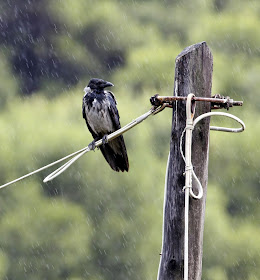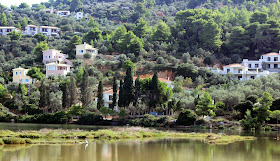Here are a few pictures from the recent holiday to Skiathos, Greece.
There’d been an overnight thunderstorm storm and in the morning still rain in the air so Sue set off on the local bus into Skiathos Town for a cool shopping trip leaving me to drive the Jimny to Aselinos. Here I could search for migrant birds.
Aselinos is a well-known beach in the north of the island, a quiet shoreline where tourists spend the day lounging on the sand and cooling off in the beachside taverna. Behind the beach is an area of low scrubby habitat, and beyond that a number of olive groves and stands of reeds, all hidden inside a well wooded valley; all in all a perfect place to bird but not in the 30 degrees heat of a typical Skiathos day.
Aselinos- Skiathos
There seemed to be Red-backed Shrikes everywhere this year, no doubt some of them locally bred but so many of them that they could only be migrants from Europe. In two weeks I didn’t see a male shrike wearing its striking colours and suspect that 90% of the ones I saw were juvenile birds. The brown colouration of the female/juveniles makes them difficult to spot, especially as they can sit motionless for many minutes on a fence, branch or on the edge of a bush where the only give away is the slow-motion up and down movement of their tail. Nor are they especially approachable and it took two weeks of trying to obtain half decent pictures.
Red-backed Shrike
Red-backed Shrike
Red-backed Shrike
Rain still threatened with occasional heavy showers which soaked the back seats of the half open Jimny. We later learned that the thunderstorms had diverted planes from Skiathos to land instead in Athens where tourists faced an on overland bus and then ferry journey to make them 12 hours late for their Skiathos holiday. Oh the joys of travel.
A wet Hooded Crow
Aselinos - Skiathos
Behind the beach were hundreds of Willow Warblers and Chiffchaffs plus dozens of Whinchats, a good number of Yellow Wagtails and a dozen or more Wheatears. Along the track and in the olive groves I found shrikes, Hoopoe, Scops Owl, Cuckoo, Sparrowhawk, Blackcap, Whitethroat, Garden Warbler, Olivaceous Warbler, Spotted Flycatcher and Wood Warbler.
Olive grove
When a couple days later I searched the same area, the sun blazed down and 99% of the birds I’d seen before were no longer there - migration in action.
Whinchat
Whinchat
Willow Warbler
Whinchat
Whinchat
The Jimny is a great vehicle for exploring the rough tracks of Skiathos, a bright red one with a white roof not the best colour scheme to serve as a hide.
Suzuki Jimny
Chiffchaff
Spotted Flycatcher
Yellow Wagtail
Yellow Wagtail
Wood Warbler
Yellow Wagtail
Yellow Wagtail
The goats give up their milk to be used in the production of the famous feta (Φέτα) cheese. This herd comprised about 150 goats.
When the sun finally came out all that birding made for thirsty work and it is just amazing what those beach tavernas can cook up for hungry birders.
More Greek Delight soon from Another Bird Blog. Book your table now.
Linking today to Stewart's World Bird Wednesday.


















































